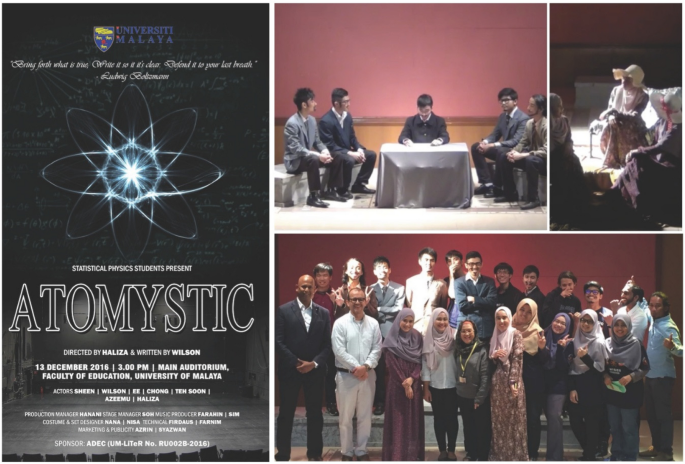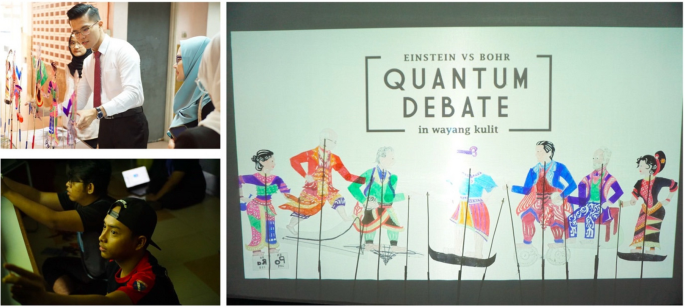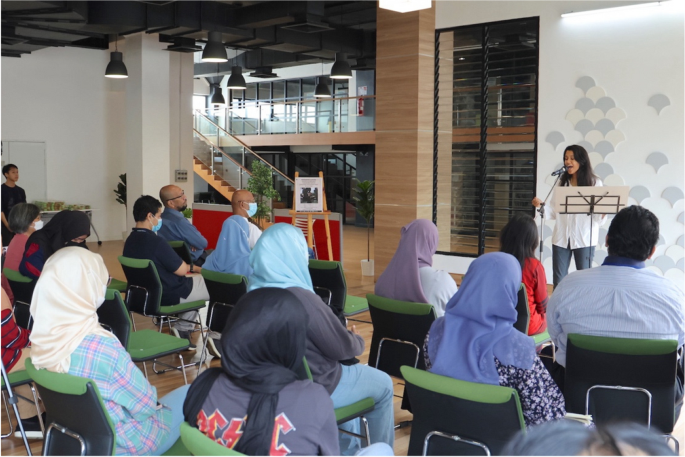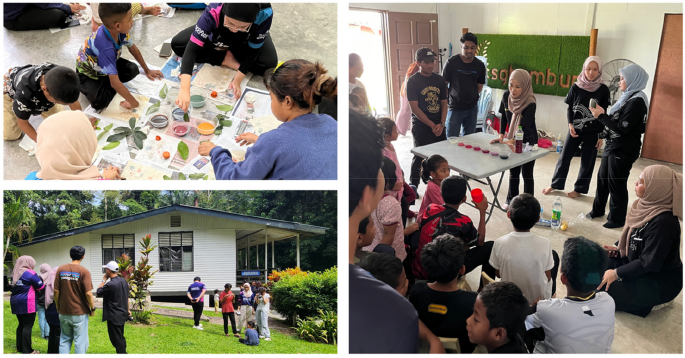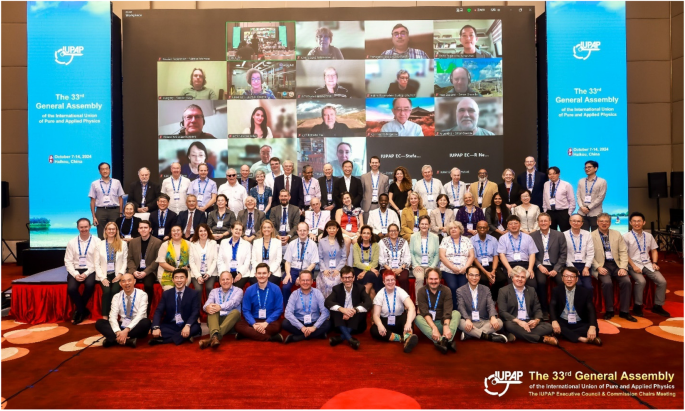8 Institut Fizik Malaysia News by Sithi V. Muniandy
8.1 Artscience approach for acculturation of holistic STEM education in Malaysia by Sithi V. Muniandy from IFM (Institut Fizik Malaysia)
The diminishing interest in pursuing higher education in the era of gig economy raises serious concerns for all sectors that need highly competent human capital. The Department of Statistics Malaysia (DOSM) reported that about 70% of 560,000 Malaysians who hold a diploma in 2019 preferred to join the workforce earliest possible [9]. Among the deciding factors for the rush to the job market are economic challenges of lower income groups, seeking short-term gratification and delusionary career prospects of university degrees.
The Science, Technology, Engineering, and Mathematics (STEM)-based talent marketplace will face the hardest hit, as Malaysia aspires to become a high-income nation by 2030. In a recent report, Dr Mas Sahidayana, the director of Universiti Malaya’s (UM) STEM Centre, noted that the enrolment rate for Form 4 students in secondary school STEM streams remains alarmingly low, showing roughly 22% (about 81,347 students) enrolled in the STEM packages in 2023 [10]. Apparently, twice as many students are opting for the arts over sciences!
Recognizing the need for teaching and learning (T&L) innovation within and beyond the standard STEM curriculum, physics lecturers led by Prof Sithi V Muniandy from the Department of Physics, Universiti Malaya established the Learning Enrichment (LearnX) action group in 2015. LearnX is experimenting with the fusion of art and creative design thinking in physics coursework. The unconventional assignments are assessed using alternative assessment rubrics, for example, following criteria used in the school of creative arts or design industries. One often hears, “Physics is fun,” but what exactly are the fun factors in physics? Merely demonstrating the “fireworks” of a physical phenomenon or a “lively” instructor with a “wow effect” may not result in a lasting impact or change in learning behavior. Physics Nobel Laureate Richard Feynman once said, “The pleasure is in finding out” [11].
Thought processes and pathways leading to discoveries in physics (and similarly in other disciplines of sciences, art, and humanities) are complex and arduous, require grit and persistence, and can come with plenty of trials, tribulation, and treacheries. Scientific endeavor, after all, is a human affair. LearnX reckons valuable lessons on ethics and etiquette, in addition to the “raw science in the making,” can be unearthed by retracing historical development of ideas and theories and applying retrospective learning mindset.
LearnX finds that the artscience approach for acculturation of scientific mind, philosophy, and affection for physics exploration (and STEM in general) can strengthen the learners’ conviction for personal growth and world-building. The history of physics/science allows us to appreciate the interplay between sociology, economics, and geopolitics context of the scientists and the societies from different eras. Many of the recent global agendas, such as climate change and ecological threats are largely driven by people-prosperity-policy-planet crisis scenario, rather than curiosity, knowledge discrepancies, and exploratory pursuits of our predecessors. Thus, it is becoming important to include human socio-cultural contexts in the education blueprint, that stresses holistic talents and characters of STEM learners and educators.
8.2 Artscience and Worldbuilding
The term “artscience” was introduced by Todd Siler in his book “Breaking the Mind Barrier” [12]. Artscience’s manifesto advocates integration of all disciplines of knowledge with a vision towards re-humanization of our worldviews [13]. Almost all major artistic advances, technological breakthroughs, scientific discoveries and innovations since the beginning of civilization have artscience DNAs. The key objective of artscience is to inspire open-mindedness, curiosity, creativity, imagination, critical thinking and problem solving through innovation and collaboration. Artscience can be interpreted as the third stream that complements the existing STEM + Art, and STEAM education movements.
Worldbuilding is a creative process of constructing an imagined world. The notion of “future-proof X” is, to some extent, worldbuilding of an imagined X, in anticipation of uncertainties and fragilities ahead of us. Interestingly, the term “world-building” appeared in the 1920s in the writing of astrophysicist A.S. Eddington, in his work “Space Time and Gravitation: An Outline of the General Relativity Theory,” where the term “world-building” was used to describe hypothetical worlds with different physical laws [14]. Worldbuilding has deeply rooted and spread in science fiction or fantasy literature and in the entertainment industries. To some extent, current human evolution is driven by digital worldbuilding and less by natural selection. Ideation of scientific concepts and their grounding in verified laws of nature should make an exciting storyboard. We have plenty of “superstar celebrities” in science. In the following, we showcase a few artscience activities, carried out by LearnX with the support of various funding agencies.
8.3 Physics theatre—atomystic
LearnX’s first example of artscience activity was the physics theatre in 2016, carried out by a group of fifteen second year physics students taking Statistical Physics course at the Department of Physics, Universiti Malaya. As part of coursework assignment, the students were challenged to showcase their artistic talents by writing, producing, and performing a theater called “ATOMYSTIC.” The 45-min theater was set in the nineteenth century styled wardrobe and stage ambiance re-enacted the trails of events, leading to the intense Lubeck meeting debate (1895) between the atomists led by Ludwig Boltzmann (1844–1906) against his critics (Ostwald, Mach, and others) who strongly held alternative worldview based on the concept of energy (energetics). Through this production, the students learned the historical account of Boltzmann’s struggle to get his H-theorem accepted. Along the way, students appreciated what led to the Boltzmann distribution, microscopic view of entropy; hence, the second law of thermodynamics that they encountered in the textbook. The students were so excited to know that the renowned Malaysian actor-director, Datuk Zahim Albakri, was present in the audience and provided his critics of the theater. He was really impressed by the brilliant performance of physics-trained first-time theater performers and applauded LearnX’ unconventional T&L activities (Fig. 12).
8.4 Physics puppetry—quantum debate in Wayang Kulit
The second example of artscience activity was carried out in 2018 (before the COVID-19), capturing the debate between the giants of physics, Albert Einstein and Niels Bohr on the adequacy of quantum theory in describing the physical reality at the microscopic scale. Aptly called the “Quantum Debate in Wayang Kulit,” a group of 16 students taking the Statistical Physics course were assigned a coursework assignment to create a script and the storyboard for multi-character puppets of key physicists involved in the first Quantum Revolution (Quantum 1.0). The students designed brightly colored puppets made of hard plastics and staged the shadow puppet (“wayang kulit”) show, which received thunderous applause from a full house audience. Figure 13 shows the shadow screen and students involved in the production. The students successfully presented the essence of Manjit Kumar’s book, “Quantum: Einstein, Bohr, and the Great Debate About the Nature of Reality” in a 30-min shadow puppet show [15]. Communicating quantum physics to a broader audience using alternative medium such as performing art is not an easy feat. Thus, students’ learning achievements were assessed as a team effort in accomplishing the task. The production crews were divided into four different teams—creative story telling team, puppet designers and puppeteers, stage and technical crews, and publicity and reporting team. An audience response survey was used to evaluate the artistic quality of the production. The lecturer assessed the accuracy of the scientific and historical facts that were presented. The students were given the chance to self-assess their physics understanding and soft skills enhancement after participating in this event that went into the overall grade. Appraisal from the renowned Fusion Wayang Kulit co-founder, Mr Tintoy Chuo, who had kindly mentored the students and attended the show, proved once again that artscience can be a potent medium for learning different skills that are often kept away for physics/STEM education. Expanding on this success, LearnX is preparing a sequel, “Quantum Revolutions in Wayang Kulit” for the International Year of Quantum Science and Technology (IYQST2025).
8.5 Read, reflect, and recite—SDG, poetry, and entropy
Artists and scientists are reinventing their collaborations by using mixed media to raise awareness of various global challenges, such as global warming, environmental, and social economic issues. Emerging out of the COVID-19 movement control and back into face-to-face learning in December 2022, a group of 70 students taking the Statistical Physics course (yes, the same course, same lecturer but different students) were asked to champion the climate agenda by relating their chosen Sustainable Development Goals (SDG) with poetry. In collaboration with the University of Malaya Library, a poem recital program called Read & Recite (“Baca & Bicara”) was organized at the Universiti Malaya Za’aba Memorial Library. Students in six groups had to source the poems by Malaysian poets from the University’s library and then to recite their chosen poems to an open audience. Besides showcasing heart-rendering recitals depicting environmental crises and hopes for better future with local SDG mindset, the students were also required to analyze the information entropy of the poems, relating it to their course syllabus in statistical physics, linguistic theory, and culture (Fig. 14).
8.6 Indigenous STEM (iSTEM)—humanity bond with water (H-Bond)
Malaysia’s Education Blueprint (2015–2025) emphasizes holistic education for all citizens, with the aim that no child or youth is left behind [16]. Adoption of digital technologies in teaching and learning (T&L) is becoming increasingly important, especially post-COVID-19. Despite massive digital transformation nationwide, disparity in the access to T&L technology continues to widen. Direct deployment of standardized STEM curriculum and T&L approaches for different demographics produce mixed results. Specifically, the overall performance of school children from the indigenous (Orang Asli) community in science education is lagging far behind the national average. Osman et al. showed indigenous children encounter difficulty in understanding scientific concepts of science, which they feel are foreign to their culture and remote from their environment [17]. “Forest STEM” modules offer experiential learning opportunities, where indigenous learners use natural resources such as water, soil, fauna, and flora with strong connection to environment in T&L activities [18].
In 2023, LearnX secured a two-year onsemi Giving Now grant (IFC001-2023) to conduct an indigenous STEM project titled “Humanity Bond With Water: Empowering Indigenous Youths Content Creation Skills With Water-inspired Artscience,” or, in short, H-Bond. H-Bond rests on four elements: indigenous community (students-teachers-parents), iSTEM content creation skills, natural water, and indigenous artscience. H-Bond team consists of multi-disciplinary expertise (Prof. Dr. Sithi V Muniandy (Physics), Prof. Dr. Norlidah Alias (STEM Education) with her colleagues, Assoc. Prof. Dr. Dorothy Dewitt, Assoc. Prof. Dr. Mohd Nazri Abdul Rahman, Dr. Mohd Razip Bajuri, Dr. Mohd Shahril Nizam Shaharom, and Assoc. Prof. Dr. Roslina Ismail (Creative Arts) with her colleague Dr. Dzul Afiq Zakaria.
LearnX team designed coursework assignment for undergraduate courses (Classical Mechanics and Statistical Physics), where real-world scenarios from the indigenous community were turned into H-Bond problem-based learning activities. The university physics students were given the opportunities to act as mentors for primary school students from the indigenous community. Teachers and students from Sekolah Kebangsaan Putra Simpang Durian, Jelebu, were concurrently assigned with iSTEM group projects (e.g., gravity flow model and virtual reality simulation of water-based crisis). The preliminary outcomes of the iSTEM activities were amazing with students and teachers highly motivated in exploring their surrounding environments and soliciting indigenous knowledge from community’s elders.
Several exciting indigenous artscience workshops, as shown in Fig. 15, were co-designed with the indigenous community, involving two groups (i) the Mah Meri community (Kg Orang Asli Sg Bumbun, Pulau Carey, Selangor; iSTEM—optics and sound, water-based natural pigment fabric art) and (ii) Temuan community (Kg Orang Asli Bt 16 Gombak, Selangor; iSTEM video documentary production, water quality analysis, nature art). The participants were mostly primary-lower secondary school students (7–16 years old). The young learners were quick to demonstrate self-learning motivation and creativity, achieving surprising results that exceeded H-Bond’s expectations. Indigenous folklores, wisdom, and frugal solutions for basic needs are rich in ecological intelligence narratives and were captured through the digital artscience contents. Integrating storytelling with indigenous artscience provides deep STEM perspectives with perennial worldbuilding views from indigenous communities. Ethos of indigenous communities are universal and shared across the planet Fig. 16.
In summary, artscience activities experimented by LearnX offer opportunities for creativity, identity building, self-actualization, cognitive skills, and risk taking. Such practices help appreciate and retain abstract STEM concepts while activating fine motor skills through kinesthetics, auditory, and visual sensory experiences. Students were stimulated to exercise a variety of intelligence, self-expression, and multi-worldview. Artscience in STEM curriculum, along with self-motivated learning grounded in deeper heutagogy philosophy, should be encouraged as it offers opportunities for holistic learning experiences, sustained creativity, and promotion of education for sustainable development.
References
-
J.J. Hopfield, Neural networks and physical systems with emergent collective computational abilities. Proc. Natl. Acad. Sci. 79(8), 2554–58 (1982)
-
J.J. Hopfield, Neuronswith graded response have collective computational properties like those of two-state neurons. Proc. Natl. Acad. Sci. 81(10), 3088–92 (1984)
-
J.J. Hopfield, Artificial neural networks. IEEE Circuits Devices Mag. 4(5), 3–10 (1988)
-
G.E. Hinton, Computation by neural networks. Nat. Neurosci. 3(11), 1170 (2000)
-
J.J. Hopfield, Pattern recognition computation using action potential timing for stimulus representation. Nature 376(6535), 33–36 (1995)
-
Y. LeCun, Y. Bengio, G.E. Hinton, Deep learning. Nature 521(7553), 436–44 (2015)
-
A. Krizhevsky, I. Sutskever, G.E. Hinton, ImageNet classification with deep convolutional neural networks. Commun. ACM 60(6), 84–90 (2017)
-
D.E. Rumelhart, G.E. Hinton, R.J. Williams, Learning representations by back-propagating errors. Nature 323(6088), 533–36 (1986)
-
Editorial, 72% of SPM graduates prefer being influencers, E-Hailing drivers,” theSun, Aug 3, 2022. https://thesun.my/style-life/going-viral/72-of-spm-graduates-prefer-being-influencers-e-hailing-drivers-KX9536950. Accessed 24 Oct 2024.
-
R. Loheswar, Experts call for early-years STEM education to address critical engineering labour shortage in Malaysia. MalayMail, May 22, 2024. https://www.malaymail.com/news/malaysia/2024/05/22/experts-call-for-early-years-stem-education-to-address-critical-engineering-labour-shortage-in-malaysia/134795. Accessed 24 Oct 2024
-
R.P. Feynman, The Pleasure of Finding Things Out: The Best Short Works of Richard P. Feynman (Perseus Books, 1999)
-
Todd Siler, Breaking the Mind Barrier: The Artscience of Neurocosmology (Simon & Schuster, 1997)
-
R.S. Root-Bernstein, T. Siler, A. Brown, K. Snelson, ArtScience: integrative collaboration to create a sustainable future. LEONARDO 44(3), 192 (2011)
-
A. S. Eddington, Space, Time and Gravitation: An Outline of the General Relativity Theory (Cambridge University Press, 1920)
-
M. Kumar, Quantum: Einstein, Bohr, and the Great Debate About the Nature of Reality (W.W. Norton & Company, 2011)
-
Malaysia Education Blueprint 2013-2025, Prime Minister's Office of Malaysia. https://www.pmo.gov.my/wp-content/uploads/2019/07/Malaysia-Education-Blueprint-2013-2025.pdf
-
A. Osman, L. Halim, N.M. Arsad, Fundsof knowledge of the Semai Orang Asli children in science learning: a needs analysis. Int. J. Educ. 15(2), 48–65 (2023)
-
N. Z. Che Ghani, Implementation of Forest STEM Module based on Moral Values in Indigenous Education (Master’s thesis, Universiti Teknologi Malaysia, 2021)
Author information
Authors and Affiliations
Consortia
Contributions
Authors read and approved the final manuscript.
Ethics declarations
Competing interests
The authors declare that they have no competing interests.
Additional information
Publisher’s Note
Springer Nature remains neutral with regard to jurisdictional claims in published maps and institutional affiliations.


